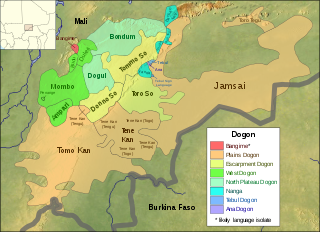Related Research Articles
Vaeakau-Taumako is a Polynesian language spoken in some of the Reef Islands as well as in the Taumako Islands in the Temotu province of the Solomon Islands.
Taba is a Malayo-Polynesian language of the South Halmahera–West New Guinea group. It is spoken mostly on the islands of Makian, Kayoa and southern Halmahera in North Maluku province of Indonesia by about 20,000 people.
Manam is a Kairiru–Manam language spoken mainly on the volcanic Manam Island, northeast of New Guinea.
Tamambo, or Malo, is an Oceanic language spoken by 4,000 people on Malo and nearby islands in Vanuatu. It is one of the most conservative Southern Oceanic languages.
Yabem, or Jabêm, is an Austronesian language of Papua New Guinea.
Hoava is an Oceanic language spoken by 1000–1500 people on New Georgia Island, Solomon Islands. Speakers of Hoava are multilingual and usually also speak Roviana, Marovo, Solomon Islands Pijin, English.
Ughele is an Oceanic language spoken by about 1200 people on Rendova Island, located in the Western Province of the Solomon Islands.

Bangime is a language isolate spoken by 3,500 ethnic Dogon in seven villages in southern Mali, who call themselves the bàŋɡá–ndɛ̀. Bangande is the name of the ethnicity of this community and their population grows at a rate of 2.5% per year. The Bangande consider themselves to be Dogon, but other Dogon people insist they are not. Bangime is an endangered language classified as 6a - Vigorous by Ethnologue. Long known to be highly divergent from the (other) Dogon languages, it was first proposed as a possible isolate by Blench (2005). Heath and Hantgan have hypothesized that the cliffs surrounding the Bangande valley provided isolation of the language as well as safety for Bangande people. Even though Bangime is not closely related to Dogon languages, the Bangande still consider their language to be Dogon. Hantgan and List report that Bangime speakers seem unaware that it is not mutually intelligible with any Dogon language.
Biak, also known as Biak-Numfor, Noefoor, Mafoor, Mefoor, Nufoor, Mafoorsch, Myfoorsch and Noefoorsch, is an Austronesian language of the South Halmahera-West New Guinea subgroup of the Eastern Malayo-Polynesian languages.
Paamese, or Paama, is the language of the island of Paama in Northern Vanuatu. There is no indigenous term for the language; however linguists have adopted the term Paamese to refer to it. Both a grammar and a dictionary of Paamese have been produced by Terry Crowley.
Adang is a Papuan language spoken on the island of Alor in Indonesia. The language is agglutinative. The Hamap dialect is sometimes treated as a separate language; on the other hand, Kabola, which is sociolinguistically distinct, is sometimes included. Adang, Hamap and Kabola are considered a dialect chain. Adang is endangered as fewer speakers raise their children in Adang, instead opting for Indonesian.
Buru or Buruese is a Malayo-Polynesian language of the Central Maluku branch. In 1991 it was spoken by approximately 45,000 Buru people who live on the Indonesian island of Buru. It is also preserved in the Buru communities on Ambon and some other Maluku Islands, as well as in the Indonesian capital Jakarta and in the Netherlands.
Ledo Kaili is the largest member of the Kaili languages, which are a dialect chain within the Kaili–Pamona language family. These languages are spoken in Central Sulawesi (Indonesia). Kaili with all of its dialects is one of the largest languages in Sulawesi. One third of the population of Sulawesi Tengah province were (1979) native speakers of a Kaili language. The object language of this article is the main dialect Ledo, which is spoken in the Donggala and Sigi districts (Kabupaten) in and around the provincial capital Palu.
Buli, or Kanjaga, is a Gur language of Ghana primarily spoken in the Builsa District, located in the Upper East Region of the country. It is an SVO language and has 200 000 speakers.
Mavea is an Oceanic language spoken on Mavea Island in Vanuatu, off the eastern coast of Espiritu Santo. It belongs to the North–Central Vanuatu linkage of Southern Oceanic. The total population of the island is approximately 172, with only 34 fluent speakers of the Mavea language reported in 2008.
Dom is a Trans–New Guinea language of the Eastern Group of the Chimbu family, spoken in the Gumine and Sinasina Districts of Chimbu Province and in some other isolated settlements in the western highlands of Papua New Guinea.
North Moluccan Malay is a Malay-based creole language spoken on Ternate, Tidore, Halmahera, and Sula Islands, North Maluku for intergroup communications. The local name of the language is Bahasa Pasar, and the name Ternate Malay is also used, after the main ethnic group speaking the language. Since North Moluccan Malay is used primarily for spoken communication, there is no standardized orthography.

Toʼabaita, also known as Toqabaqita, Toʼambaita, Malu and Maluʼu, is a language spoken by the people living at the north-western tip of Malaita Island, of South Eastern Solomon Islands. Toʼabaita is an Austronesian language.
Lengo is a Southeast Solomonic language of Guadalcanal.
Neverver (Nevwervwer), also known as Lingarak, is an Oceanic language. Neverver is spoken in Malampa Province, in central Malekula, Vanuatu. The names of the villages on Malekula Island where Neverver is spoken are Lingarakh and Limap.
References
- ↑ Moi at Ethnologue (18th ed., 2015) (subscription required)
- ↑ Menick, Raymond (1995). Moi, a language of the West Papuan phylum: A preview. Baak, Connie and Bakker, Mary and van der Meij, Dick (eds.), Tales from a concave world: Liber amicorum Bert Voorhoeve: Leiden University. pp. 55–73.
- ↑ Menick, Raymond H. (1996). "Verb sequences in Moi" (PDF). Studies in Irian languages. 1: 41.
- 1 2 3 Menick (1996), p. 42
- ↑ Menick (1996), p. 47
- 1 2 3 4 5 6 Menick (1996), p. 43
- 1 2 Menick (1996), p. 50